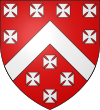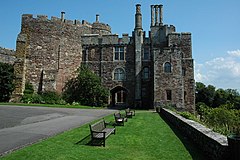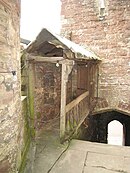| Berkeley Castle | |
|---|---|
| Berkeley, Gloucestershire | |
 Berkeley Castle viewed from the southwest Berkeley Castle viewed from the southwest | |
 | |
| Coordinates | 51°41′19″N 02°27′25″W / 51.68861°N 2.45694°W / 51.68861; -2.45694 grid reference ST685989 |
| Listed Building – Grade I | |
| Official name | Berkeley Castle |
| Designated | 21 October 1952 |
| Reference no. | 1340692 |

Berkeley Castle (/ˈbɑːrkli/ BARK-lee; historically sometimes spelled as Berkley Castle or Barkley Castle) is a castle in the town of Berkeley, Gloucestershire, England. The castle's origins date back to the 11th century, being designated by English Heritage as a Grade I-listed building.
The castle, traditionally believed to have been the scene of the murder of King Edward II in 1327, has remained in the possession of the Berkeley family since they reconstructed it in the 12th century, except for a period of royal ownership under the Tudors.
The Berkeley barony having separated from the earldom in 1882, the 8th and last Earl of Berkeley (1865–1942) bequeathed the ancestral seat to his 13th cousin, Captain Robert Berkeley, of Spetchley Park, Worcestershire (1898–1969), whose grandson, Charles Berkeley (born 1968), High Sheriff of Gloucestershire for 2019/20, inherited the castle and estate from his father, Major John Berkeley (1931–2017).
Since 1956, Berkeley Castle has been open to visitors (for a fee) and remains open from April to November (in 2023) on certain days of the week. The property has also been available for rent for private events.
Construction
The first castle at Berkeley was a motte-and-bailey, built around 1067 by William FitzOsbern shortly after the Conquest. This was subsequently held by three generations of the first Berkeley family, all called Roger de Berkeley, and rebuilt by them in the first half of the 12th century. The last Roger de Berkeley was dispossessed in 1152 for withholding his allegiance from the House of Plantagenet during the conflict of the Anarchy, and the feudal barony of Berkeley was then granted to Robert Fitzharding, a wealthy burgess of Bristol and supporter of the Plantagenets. He and Eva fitz Harding were the founders of the Berkeley family which still owns the castle.

In 1153–54, Fitzharding received a royal charter from King Henry II giving him permission to rebuild the castle. Fitzharding built the circular shell keep between 1153 and 1156, probably on the site of the former motte. The building of the curtain wall followed, probably between 1160 & 1190 by Robert and then by his son Sir Maurice Berkeley.
Much of the rest of Berkeley Castle is 14th century and was built for Thomas de Berkeley, 3rd Baron Berkeley: Thorpe's Tower, to the north of the keep, the inner gatehouse to its southwest, and other buildings of the inner bailey.
Murder of Edward II
Berkeley Castle was ransacked in 1326 by the forces of Hugh Despenser, the favourite of Edward II. Then in 1327, King Edward was deposed by his wife Queen Isabella and her ally Roger Mortimer, and placed in the joint custody of Mortimer's son-in-law, Thomas de Berkeley, and de Berkeley's brother-in-law, John Maltravers. They brought Edward to Berkeley Castle, and held him there for five months from April to September. During that time a band of Edward's supporters attacked, entered the castle and rescued him, only for him to be recaptured soon afterwards. It is possible that his captors then moved him around between several castles to make further rescue more difficult, before returning him to Berkeley in September. Some commentators have claimed that Edward's escape was actually successful, and conjecture someone else was later murdered in his place.
Historical sources record that Edward was murdered there on 21 September 1327. Raphael Holinshed's Chronicles (1587 edition), drawing on earlier sources, describes Edward's murder in detail:

they came suddenlie one night into the chamber where he laie in bed fast asléepe, and with heavie featherbeds or a table (as some write) being cast upon him, they kept him down and withall put into his fundament an horne, and through the same they thrust up into his bodie an hot spit, or (as other have) through the pipe of a trumpet a plumbers instrument of iron made verie hot, the which passing up into his intrailes, and being rolled to and fro, burnt the same, but so as no appearance of any wound or hurt outwardlie might be once perceived. His crie did moove manie within the castell and towne of Berkley to compassion, plainelie hearing him utter a wailefull noise, as the tormentors were about to murther him, so that diverse being awakened therewith (as they themselues confessed) praied heartilie to God to receive his soule, when they understood by his crie what the matter ment.
Christopher Marlowe's tragedy Edward II (The troublesome raigne and lamentable death of Edward the second, King of England, first published 1594) depicts the murder at Berkeley Castle, using props mentioned in Holinshed, and popular stories of a red-hot poker or suffocation continue to circulate. The cell where Edward is supposed to have been imprisoned and murdered can still be seen, along with the adjacent 11 m (36 ft) deep dungeon, which supposedly echoes the events of the murder every year on 21 September. Holinshed's account records that, leading up to the murder, Edward's keepers "lodged the miserable prisoner in a chamber ouer a foule filthie dungeon, full of dead carrion, trusting so to make an end of him, with the abhominable stinch thereof: but he bearing it out stronglie, as a man of a tough nature, continued still in life."
The account given to Parliament at the time was that Edward had met with a fatal accident, but Holinshed and other historical sources record that great effort was made to keep the murder secret. The body was embalmed and remained lying in state at Berkeley for a month, in the Chapel of St John within the castle keep, before Thomas de Berkeley escorted it to Gloucester Abbey for burial. Thomas was later charged with being an accessory to the murder, but his defence was that it was carried out by the agents of Roger Mortimer while he was away from the castle, and in 1337 he was cleared of all charges.
Later history

In 1384 Katharine, Lady Berkeley, founded Katharine Lady Berkeley's School; such colleges were unusual in medieval times and Lady Berkeley was one of the first in England to found a small fully endowed school.
In the 14th century, the Great Hall was given a new roof and it is here the last court jester in England, Dickie Pearce, died after falling from the minstrels' gallery. His tomb is in St Mary's churchyard, adjacent to the castle. Adjoining the Great Hall was the Chapel of St Mary (now the Morning Room) with its painted wooden vaulted ceilings and a biblical passage, written in Norman French.
A dispute about the ownership of Berkeley Castle between Thomas Talbot, 2nd Viscount Lisle, and William Berkeley, 2nd Baron Berkeley, led to the Battle of Nibley Green.
Henry VIII and Anne Boleyn visited Berkeley in August 1535, after staying at Gloucester. In the late 16th century Queen Elizabeth I visited the castle and played bowls on its bowling green.
During the First English Civil War, the castle was held by a Royalist garrison and was captured in 1645 by a Parliamentarian force under Colonel Thomas Rainsborough; after a short siege that saw cannon being fired at point-blank range from the adjacent church roof of Saint Mary the Virgin, the garrison surrendered. As was usual the walls were left breached after this siege, but the Berkeley family were allowed to retain ownership on condition that they never repair the damage to the Keep and Outer Bailey; this is still enforced today by the Act of Parliament drawn up at the time. According to the Pevsner Architectural Guides the breach is partially filled by a subsequent 'modern' rebuild, but this only amounts to a low garden wall, to stop people falling 28 feet from the Keep Garden, the original Castle's "motte".

In the early 18th century the 4th Earl of Berkeley planted a pine that was reputed to have been grown from a cutting taken from a tree at the Battle of Culloden. Between 1748 and 1753 the church tower of St Mary's, Berkeley, was demolished and rebuilt beside the church so that it would not impede the clear line of fire from the castle. In the early 20th century the 8th Earl of Berkeley repaired and remodelled parts of the castle and added a new porch in the same Gothic style as the rest of the building.

A restoration appeal was launched in 2006 to raise £5.5 million needed to renovate and restore the Norman building. The castle is the third-oldest continuously occupied castle in England, after the royal fortresses of the Tower of London and Windsor Castle, and the oldest to be continuously family-owned and occupied. It contains an antique four-poster bed that has been identified as the piece of furniture remaining longest in continuous use in the Great Britain by the same family.
The Berkeley Castle Charitable Trust received a grant from the Cotswolds LEADER Programme in 2022; the funds were used to help renovate the Education Room.
In modern culture
Berkeley Castle was used for many scenes for the 2003 television film of The Other Boleyn Girl. More recently the castle and grounds have been used for the external shots of the Valencian castle in Galavant. In 2019, the castle – both interior and exterior – was used as a filming location for Season 2 of The Spanish Princess.
The castle is featured in an episode of the 2017 season of the genealogy documentary television series Who Do You Think You Are?, when American actress Courteney Cox learnt of her ancestry. Cox was informed that she is a 21-generation direct descendant of Thomas de Berkeley, 3rd Baron Berkeley and 22-generation descendant of Lord Berkeley's father-in-law, Roger Mortimer, 1st Earl of March, also learning of their parts in the murder of King Edward II of England in 1327. The Castle's website lists additional productions which have completed some filming there.
Two Royal Navy ships have been named Berkeley Castle after the Earls of Berkeley, as was a Great Western Railway steam locomotive.
See also
References
- ^ "Berkeley Castle". historicengland.org.uk. Archived from the original on 13 March 2016. Retrieved 25 August 2010.
- Kingsley, Nicholas (2001). The Country Houses of Gloucestershire, Vol.1 1500-1660. Chichester: Phillimore. pp. 51–54. ISBN 1-86077-124-6.
- ^ Sumption, Jonathan (5 April 2003). "Plotting the past". The Guardian. London. Archived from the original on 10 September 2014. Retrieved 25 August 2010.
- According to an article by James Lees-Milne in the 18th edition of Burke's Landed Gentry, Volume 1 (1965).
- www.berkeley-castle.com
- www.burkespeerage.com
- www.highsheriffofgloucestershire.org.uk
- www.gloucestershirelive.co.uk
- "Head of historic Gloucestershire family and owner of Berkeley Castle John Berkeley dies". Gloucestershire Live. 17 November 2017. Retrieved 7 October 2023.
- "Berkeley Castle is open from Sunday to Wednesday every week from 2nd April to 5th November". Retrieved 7 October 2023.
- ^ Verey, David; Brooks, Alan (2002). Pevsner Architectural Guide, Gloucestershire 2: The Vale and The Forest of Dean. New Haven: Yale University Press. pp. 176–178. ISBN 0-300-09733-6.
- Pine, L.G. (1972). The New Extinct Peerage 1884-1971. London: Heraldry Today. pp. 25–26. ISBN 0-900455-23-3.
- Sivier, David (2002). Anglo-Saxon and Norman Bristol. Stroud, Gloucestershire: Tempus. pp. 75–76. ISBN 0-7524-2533-1.
- Bettey, Joseph (2000). Rogan, John (ed.). Bristol Cathedral: History and Architecture. Charleston: Tempus. pp. 15–19. ISBN 0-7524-1482-8.
- ^ Burke (1999). Burke's Peerage and Baronetage, Vol.1. Switzerland: Burke's Peerage. p. 254. ISBN 2-940085-02-1.
- ^ Doherty, Paul (2003). Isabella and the Strange Death of Edward II. London: Robinson. ISBN 1-84119-843-9.
- ^ Greenwood, Charles (1977). Famous Houses of the West Country. Kingsmead. pp. 4–7. ISBN 978-0901571878.
- "The Holinshed Texts (1587, Volume 6, p. 341)". english.nsms.ox.ac.uk. Archived from the original on 22 December 2017. Retrieved 18 December 2017.
- "Marlowe's Edward II, 1612". The British Library. Archived from the original on 6 September 2020. Retrieved 18 December 2017.
- Brandon, David; Brooke, Alan (31 October 2009). "The most haunted places in Britain". The Guardian. London. Archived from the original on 23 October 2015. Retrieved 25 August 2010.
- "The Holinshed Texts (1587, Volume 6, p. 341)". english.nsms.ox.ac.uk. Archived from the original on 22 December 2017. Retrieved 19 December 2017.
- "The Holinshed Texts (1587, Volume 6, p. 341)". english.nsms.ox.ac.uk. Archived from the original on 22 December 2017. Retrieved 18 December 2017.
- ^ "Berkeley [née Clivedon], Katherine, Lady Berkeley (d. 1385), benefactor". Oxford Dictionary of National Biography (online ed.). Oxford University Press. 2004. doi:10.1093/ref:odnb/54435. ISBN 978-0-19-861412-8. Retrieved 25 March 2021. (Subscription or UK public library membership required.)
- "The Last Court Jester". Cotswolds. Archived from the original on 29 July 2018. Retrieved 29 July 2018.
- ^ "Tour". Berkeley Castle. Archived from the original on 29 July 2018. Retrieved 29 July 2018.
- ^ Cooke, Robert (1957). West Country Houses. Batsford. pp. 15–19.
- Historical Manuscripts Commission, 12th Report, Appendix 9: Gloucester (London, 1891), p. 444.
- ^ "Gardens". Berkeley Castle. Archived from the original on 29 July 2018. Retrieved 29 July 2018.
- Verey, David; Brooks, Alan (2002) . Gloucestershire 2: The Vale and The Forest of Dean. The Buildings of England (3rd revised ed.). Pevsner Architectural Guides. ISBN 978-0-300-09733-7.
- "The Development of the Present Church Building". St Mary's, Berkeley. Archived from the original on 22 February 2020. Retrieved 6 September 2020.
- "Donate". Berkeley Castle. Archived from the original on 8 February 2012. Retrieved 20 October 2012.
- Ben Rankin, "Bed that dates back to medieval times is oldest still in use in Britain" Archived 6 September 2020 at the Wayback Machine, Daily Mirror, 6 March 2013. Retrieved 6 March 2013.
- "Cotswolds LEADER Funded Projects". Cotswolds Area of Outstanding Natural Beauty. Retrieved 7 October 2023.
- "Scope | Issue 16| Film Reviews". Scope.nottingham.ac.uk. Archived from the original on 27 July 2011. Retrieved 20 October 2012.
- "The Spec". Archived from the original on 15 February 2016. Retrieved 8 February 2016.
- "BEHIND THE SCENES: THE SPANISH PRINCESS". YouTube. 3 October 2020. Archived from the original on 12 December 2021. Retrieved 5 October 2020.
- SuperFan (6 March 2017). "Courteney Cox Learns Her Ancestors Were Kings and Kingslayers". Yahoo! News. Archived from the original on 30 August 2017. Retrieved 16 July 2018.
- "Berkeley Castle as a filming location". Berkeley Castle. 27 April 2020. Retrieved 7 October 2023.
- Colledge, J. J.; Warlow, Ben (2006) . Ships of the Royal Navy: The Complete Record of all Fighting Ships of the Royal Navy (Rev. ed.). London: Chatham Publishing. ISBN 978-1-86176-281-8.
- Daniel, John. "4073 'Castle' class". The Great Western Archive. Archived from the original on 25 December 2008. Retrieved 27 December 2008.
Further reading
- Prior, Stuart J.; Horton, Mark; Trimmis, Konstantinos, eds. (2023). Berkeley Castle Tales. Archaeopress.
External links
- Official Berkeley Castle website
- Berkeley Castle Project: excavations by the University of Bristol from 2005 to 2020